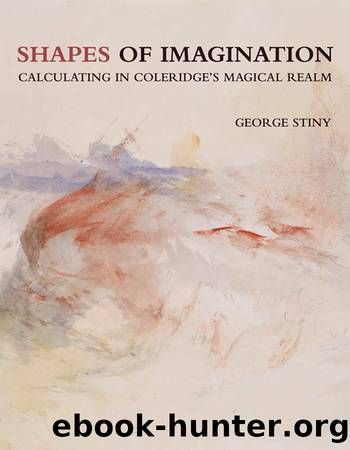Shapes of Imagination by George Stiny

Author:George Stiny [Stiny, George]
Language: eng
Format: epub
Tags: visual calculating; shape grammars; the embed-fuse cycle; Oscar Wilde; John von Neumann; Samuel Taylor Coleridge;
Publisher: MIT Press
Published: 2022-11-07T00:00:00+00:00
(In this series, I can change any term including the verticals into any of its successors in the schema x â Σ F(prt(x)), with two reciprocal rotations and a reflection in x â t(x). The term and its successor are divided with respect to x and t(x), each into four component parts/lines that are equal from term to term.22 As the series extends symmetrically past 2Ï, the hinge folds down to the base of the A, instead of up to its top. This kind of switch also goes for Reuleauxâs series of nuts and bolts.) Itâs uncannyâhow the two kinds of Aâs in my three squares are the same in one series. There are surprises galore whenever I open my eyes, and remarkable things to seeâfor example, two exaggerated Aâs in my three squares that arenât in my series and maybe a third, and the smaller M in Steingruberâs A thatâs many other things, but this is enough for the time being. It seems that visual calculating in shape grammars isnât the same as symbolic calculating in Turing machines. In Turing machines, symbols are simply as in themselves they really are. Isnât this invariance what makes calculating possible in the first placeâevery string of symbols is easy to read as an elaborate sort of coded number. What would happen without invariant symbols? What if they werenât always the same? What if symbols were each and every one a Rorschach test? I guess this spells the end of Wildeâs aesthetic formula with its warrant for ambiguity and unbridled change, and of pictures and poems, and art and design. It appears that calculating isnât seeingâunless of course, calculating is as in itself it really is not. How can this possibly be true? But thatâs what Iâve been trying to prove in âSeven Questionsâ with Coleridge, and von Neumann and Wilde, and in my expansive notes that tie in lots of others, and now, in this exhibit with my three examples to show the sweep of the embed-fuse cycle. Maybe thereâs a way to put all of this together in a single sentenceâ
Download
This site does not store any files on its server. We only index and link to content provided by other sites. Please contact the content providers to delete copyright contents if any and email us, we'll remove relevant links or contents immediately.
Wonder by R.J. Palacio(8428)
Mastering Adobe Animate 2023 - Third Edition by Joseph Labrecque(3698)
Unlabel: Selling You Without Selling Out by Marc Ecko(3573)
Ogilvy on Advertising by David Ogilvy(3481)
Hidden Persuasion: 33 psychological influence techniques in advertising by Marc Andrews & Matthijs van Leeuwen & Rick van Baaren(3453)
Drawing Cutting Edge Anatomy by Christopher Hart(3437)
The Pixar Touch by David A. Price(3343)
POP by Steven Heller(3296)
The Code Book by Simon Singh(3051)
The Art of War Visualized by Jessica Hagy(2931)
Slugfest by Reed Tucker(2921)
The Curated Closet by Anuschka Rees(2895)
Rapid Viz: A New Method for the Rapid Visualization of Ideas by Kurt Hanks & Larry Belliston(2811)
Stacked Decks by The Rotenberg Collection(2790)
365 Days of Wonder by R.J. Palacio(2734)
The Wardrobe Wakeup by Lois Joy Johnson(2716)
Keep Going by Austin Kleon(2678)
Tattoo Art by Doralba Picerno(2581)
Tell Me More by Kelly Corrigan(2578)
